Scientific name: Symphyotrichum novae-angliae (L.) G. L. Nesom
Pronounced: sim-fy-oh- TRY-kum NO-vee ANG-lee-a
Synonym: Aster novae-angliae. Pronounced: ASS-ter NO-vee ANG-lee-a
Common names: New England aster, Michaelmas daisy (MI-kull-muhs), New England daisy, hairy Michaelmas daisy
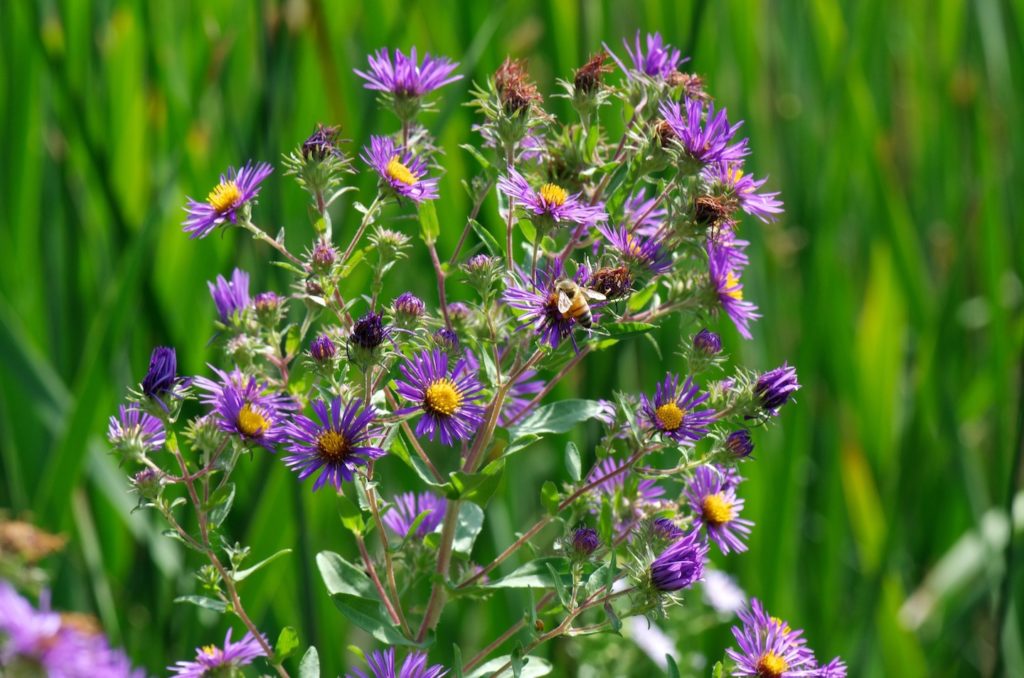
New England asters with bee. Photo: Janice Tucker
Plant family: Asteraceae/Compositae (aster/composite). Pronounced: ass-ter-AY-see-ee/kom-POZ-ee-tay
Article by Janice Tucker
As summer cedes to autumn, the countryside explodes in hues of red, orange, yellow and gold foliage accompanied by splashes of white, purple and blue of late season flowers. The vibrant, deep purple to bluish petals with golden-yellow centers of the New England aster (Symphyotrichum novae-angliae) add even more beauty to the autumnal festival of colors. By autumn most of the summer flowers have either gone to seed or are well on their way to dormancy. The summer-into-autumn blossoms step in to satisfy the flower-a-holics’ love for floral displays. More importantly, they provide a vital, late season food source for pollinators, particularly those that migrate.
A perennial wildflower that thrives in elevations spanning from sea level to over 5,000 feet, the New England aster blooms from August through October. It flourishes in its natural habitats of meadows, at the edge of woodlands, marshes, swamps, streams and shorelines as well as along roadsides and railways. Every autumn the New England aster never ceases to wow visitors at Santa Fe Botanical Garden’s Leonora Curtin Wetland Preserve where it can often be seen peeking out from a curtain of cattail leaves near the edge of the riparian zone.
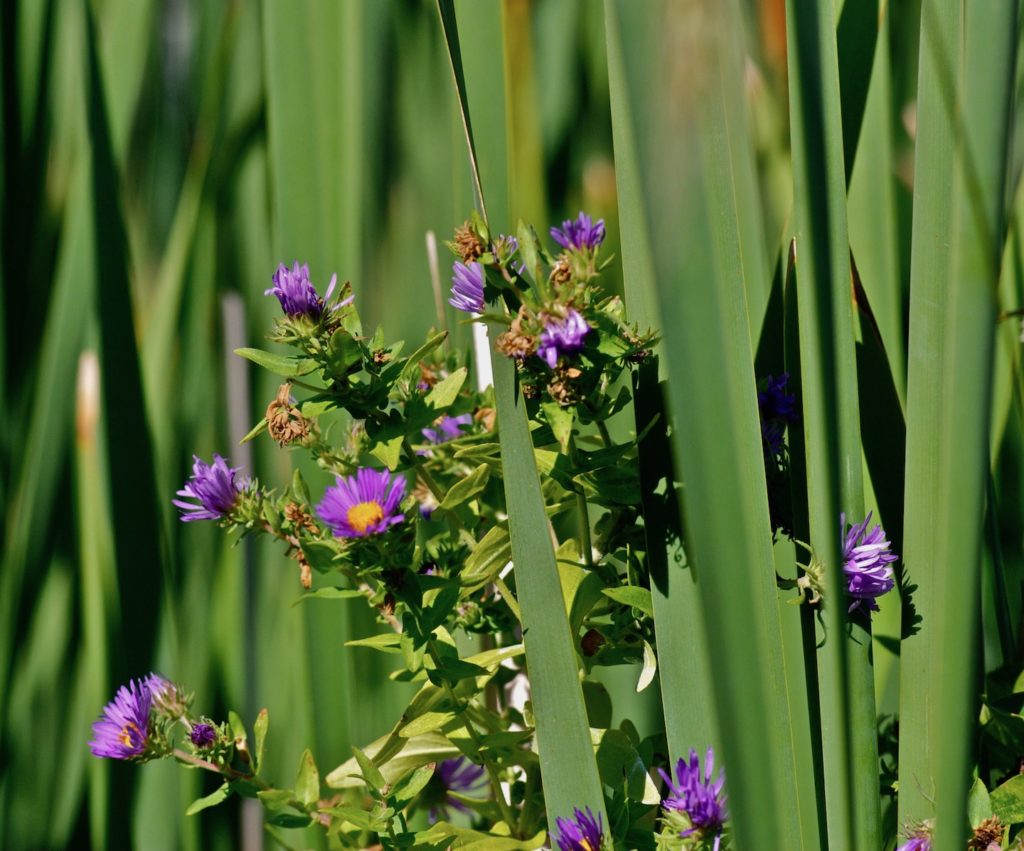
New England asters through cattail leaves. Photo: Janice Tucker
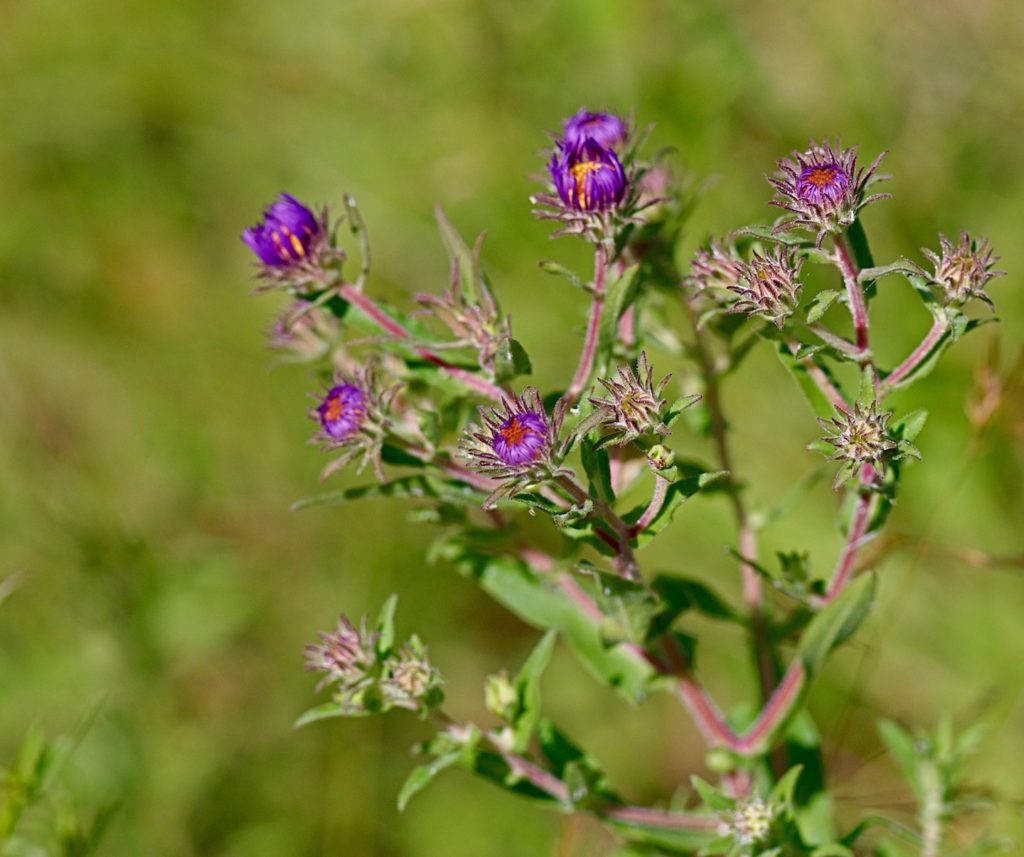
New England asters in bud. Photo: Janice Tucker.
Numerous, royal purple to blue flowers are borne near the top of hairy, brown to purplish branches, anchored to the earth by a thick, woody caudex. Tightly bound buds open up to form a fringe of 45 to 100 slender petals that surround a golden-yellow disk, jam-packed with fertile, tubular flowers. The slender, hairy leaves are sessile (no petiole) and clasp around the stem as they progress alternately upward. The hairs on the leaves are coarse on the underside and softer on the upper surface. The upright growth habit varies in height from 3 – 6 feet. After the bloom the flowers morph into round, hairy seed balls that break apart when scattered by the wind to facilitate propagation. The roots further ensure its existence by sending out fleshy rhizomes that form clumpy stands.
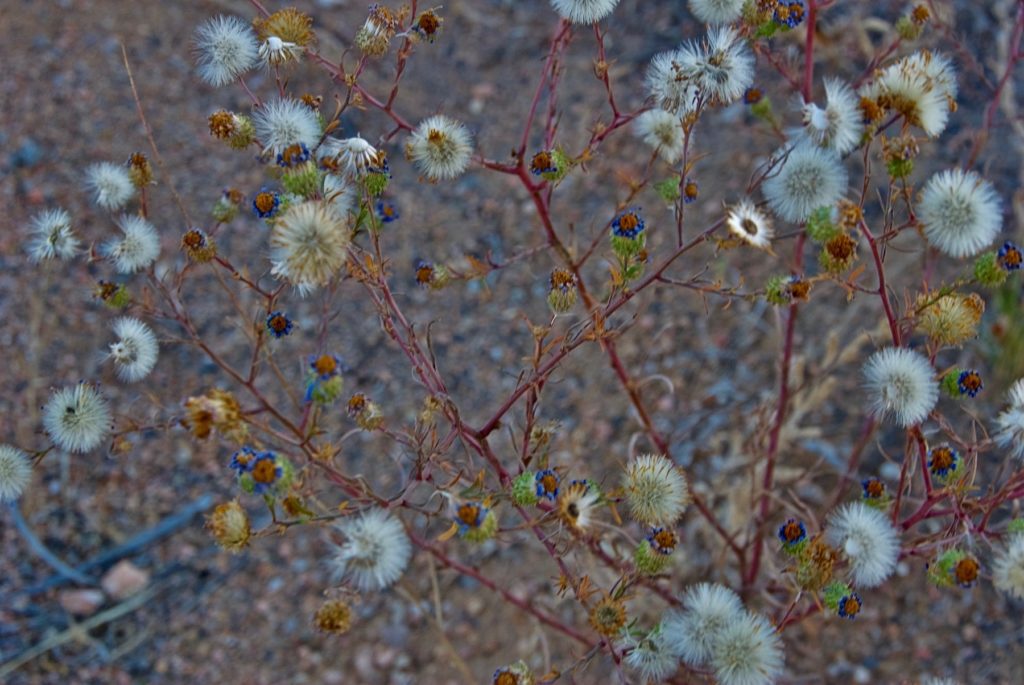
New England asters going to seed. Photo: Janice Tucker.
Attractive wildflowers have a way of finding their way into the hearts and flowerbeds of many gardeners. However, there are some things to consider when choosing the New England aster for a cultivated location. It can be pushy and can get leggy. Since those rhizomes encourage spreading, get out the trowel to dig up any new growth that pops up in unwanted areas. Pinching back some stems several weeks prior to flowering will promote a neat, shrubby look. Don’t get carried away. You don’t want to remove all the flower buds. Deadheading spent flowers will discourage self-seeding. However, for those gardeners who designate an area for wildflowers, this fall flower makes a colorful addition in a natural space without the worry of too much maintenance. Partial shade and moist, well-draining soil should keep it happy. Since many of the leaves die off when flowering begins, it may be necessary to clean up the stems to present a groomed appearance. For gardeners who like to have everything neat and tidy when winter rolls around, cut it back to the ground after flowering. The rhizomes should make certain it bounces back the following year.
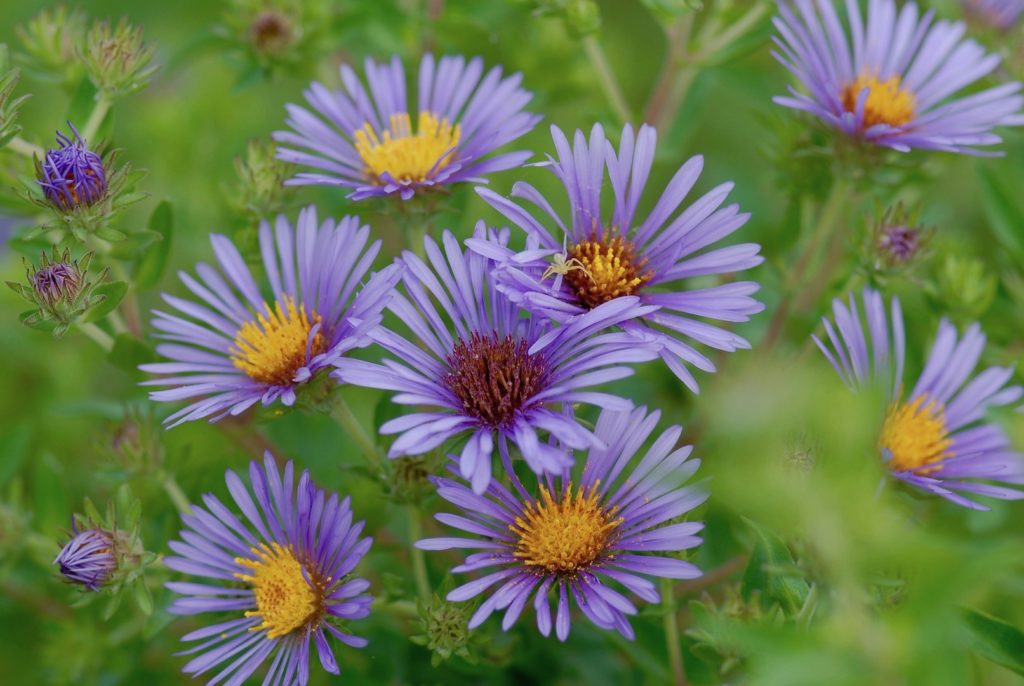
New England asters. Photo: Sonny Tucker.
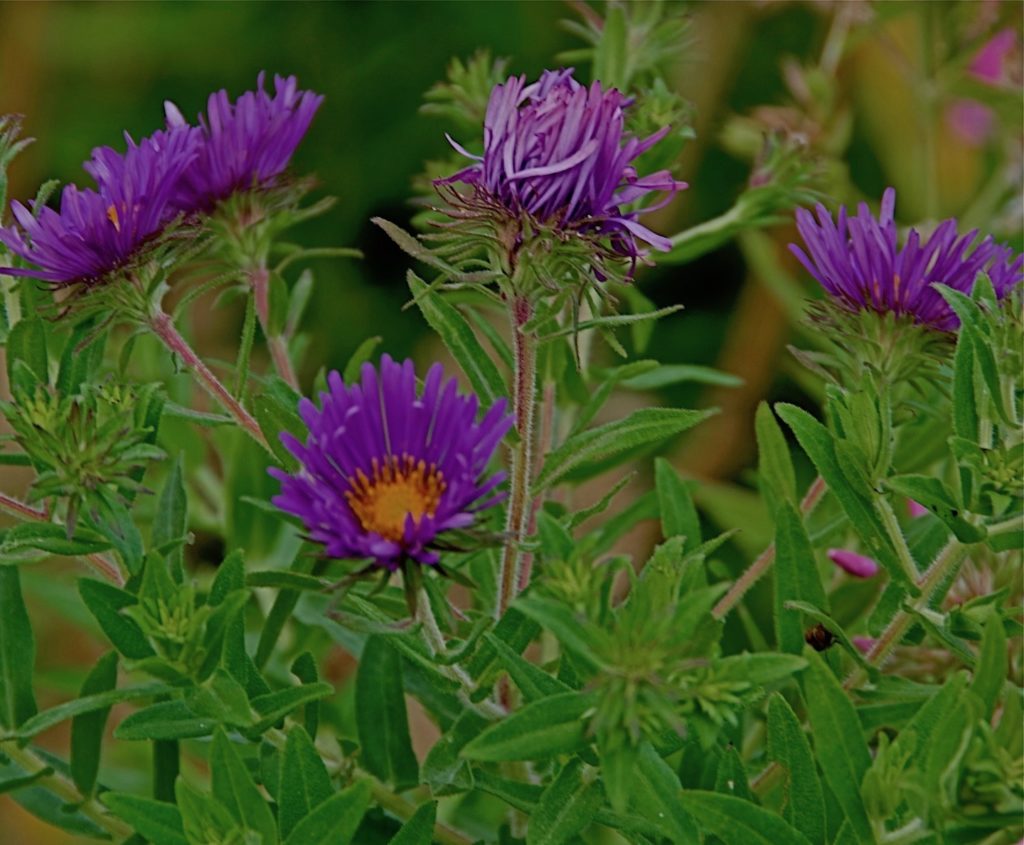
New England asters in a home environment. Photo: Janice Tucker.
In addition to attracting butterflies, moths, bees and other insects to its nectar, the New England aster is a larval host to the pearl crescent butterfly (Phyciodes tharos). The roots, leaves and even the entire plant have a traditional medicinal history for treating ailments such as catarrh, fevers, and upset stomachs.
Native to a large part of North America, the New England Aster is indigenous in the contiguous United States except Idaho, Nevada, Arizona, Texas, Louisiana and Florida. Native status extends into the Canadian provinces, excluding Alberta, Saskatchewan and Newfoundland. It has naturalized in parts of Europe where it probably escaped from cultivated gardens into welcoming, nearby natural habitats. One does wonder why it is known as the New England aster considering it is indigenous to such an expansive area. Perhaps a peek into the taxonomy world of the mid-18th century could provide a possible explanation into the reason New England has the honor of bearing this plant’s name.
In 1747 the renowned Swedish botanist, Carl Linnaeus (1707-1778), sent one of his favorite apostles, Pehr Kalm,(1716-1779) to study in North America. (Note: Linnaeus was not known for his modesty, so it is no surprise that he called his devotees/assistants,“apostles”.) Kalm chose to make the Swedish ex-patriate communities in southern New Jersey his headquarters. He traveled north to Quebec and west to Niagara Falls. During the years he was in North America, he most likely passed through some of states that officially make up New England*. Upon his return to Sweden in 1751, Mr. Kalm presented Linnaeus with an impressive collection of pressed flowers and seeds. Granted, further research could confirm or dispute that Kalm’s North American specimens did include the plant that Linnaeus named Aster novae-angliae in honor of the region known to him as New England. But it is a reasonable assumption. With so much of North America yet to be explored in the mid-1770’s, who was to know how vast the native region would turn out to be for this plant?
Aster novae-angliae remained the accepted scientific name for over 200 years. In the 1990’s American writer and botanist, Guy L. Nesom (1945), collaborated with other taxonomists in reassigning several Aster species to other genera. They reasoned it was more scientifically correct to group species into genera that share similar structure and DNA composition. Thus, the New England aster was moved to the Symphyotrichum genus but retained the specific, novae-angliae. Symphyotrichum is a compound word from the Greek: Symph (coming together, united) and trich (hair), which boils down to a meaning of “united hairs”. This is descriptive of the hairs on the seeds. The species, novae-angliae, is from the Latin, literally translated into English means, “of New England”. Aster is from the Latin, astrum, defined as, “star.” No doubt the previous name of Aster novae-angliae (star of New England) is much more poetic than the scientific name of Symphyotrichum novae-angliae (united hairs of New England??). But at least in this case a lay person can comprehend the taxonomists’ reasoning for reassigning genera.
One other common name, Michaelmas daisy, refers to the flowering time that coincides with the September 29 observance of the feast of St. Michael, which marks the beginning of autumn and shorter days. And when celebrating autumn, no one throws a bash like Mother Nature. Trees and shrubs shed their green facade to reveal their true, vivid, warm colors. Heavily ladened banquet tables groan with the annual bounty from food crops. The Michaelmas daisy, aka New England aster, and other late season bloomers contribute their fair share by bringing flowers to the party. Oh, and nectar for the pollinators…..pollinators gotta eat too!
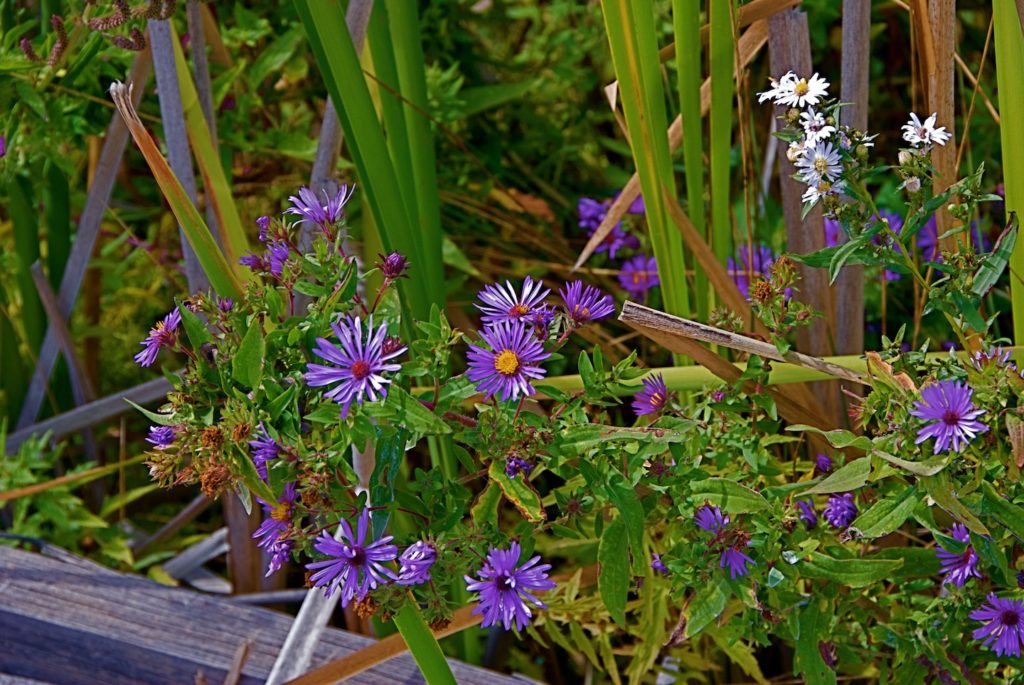
New England asters along the Leonora Curtin Wetland Preserve’s “Aster Bridge”. Photo: Janice Tucker.
*Around 1616 English explorer, John Smith (1580-1631), named the region known as New England, which consists of the following states in the northeastern United States: Maine, Vermont, New Hampshire, Massachusetts, Rhode Island and Connecticut.
Thanks to Helen Woody and Jeanne Gozigian for proofreading this article.
Sources consulted and/or cited:
Ivey, Robert DeWitt. Flowering Plants of New Mexico, Fourth Edition. Albuquerque, NM. RD & V Ivey, Publishers. 2004. Fourth edition, third printing. Print.
Johnson, Ben. “Michaelmas”. Historic UK. Web. 17 Aug. 2019. Retrieved from: https://www.historic-uk.com/CultureUK/Michaelmas/.
“Kalm, Pehr 1716-1779.Document Number: AJ-117a”. American Journeys Wisconsin Historical Society. Web. 2019. 19 August 2019. Retrieved from: http://www.americanjourneys.org/aj-117a/summary/.
“Nesom, Guy L..” Wikipedia. Web. 16 Dec. 2018. 10 Aug. 2019. Retrieved from: https://en.wikipedia.org/wiki/Guy_L._Nesom.
“New England, Colonial Period”. Wikipedia: The Free Encyclopedia. Wikimedia Foundation, Inc. Web. 18 August 2019. 19 August 2019. Retrieved from: https://en.wikipedia.org/wiki/New_England#History.
Sanders, Jack. The Secrets of Wildflowers. Guilford, CT: Lyons Press.. 2003. Print.
“Searching Botanary.” Dave’s Garden. Web. 2019. 01 Aug. 2019. Retrieved from: https://davesgarden.com/guides/botanary/search.php?search_text=asteraceae
“Symphyotrichum novae-angliae”. Garden Explorer. Santa Fe Botanical Garden. Web. 15 Aug. 2019. 18 Aug. 2019. Retrieved from:
https://santafebotanicalgarden.gardenexplorer.org/taxon-682.aspx.
“Symphyotrichum novae-angliae”. Missouri Botanical Garden Plant Finder. Web. 25 May 2019. Retrieved from: https://www.missouribotanicalgarden.org/PlantFinder/PlantFinderDetails.aspx?kempercode=b540.
“Symphyotrichum novae-angliae”. Native Plant Information Network. Lady Bird Johnson Wildflower Center. Web. 09 Dec 2013. 05 May 2019. Retrieved from: https://www.wildflower.org/plants/result.php?id_plant=syno2.
“Symphyotrichum novae-angliae (L) G.L. Nesom, New England American-Aster”. SEINet Portal Network, 2019. Web. 25 May 2019. Retrieved from: http://swbiodiversity.org/seinet/taxa/index.php?taxon=Symphyotrichum%20novae-angliae
“Symphyotrichum novae angliae (L.) G. L. Nesom (New England Aster)”. USDA, NRCS. 2019. (http://plants.usda.gov, 25 May 2019). National Plant Data Team, Greensboro, NC 27401-4901 USA.
Stearn, William T. Stearn’s Dictionary of Plant Names for Gardeners. London, England: Cassell Wellington House, Orion Publishing, Reprinted with new Preface. 2004. Print.
Taylor, David. “New England Aster (Symphyotrichum novae-angliae (L.) G. L. Nesom)”. Plant of the Week. USDA, U. S. Forest Service. Web. 25 May 2019. Retrieved from: https://www.fs.fed.us/wildflowers/plant-of-the-week/symphyotrichum_novae-angliae.shtml#.
Wulf, Andrea. The Brother Gardeners – Botany, Empire & The Birth of an Obsession. New York, NY: Alfred A. Knopf, a division of Random House, Inc. 2010. Fourth printing. Print.


